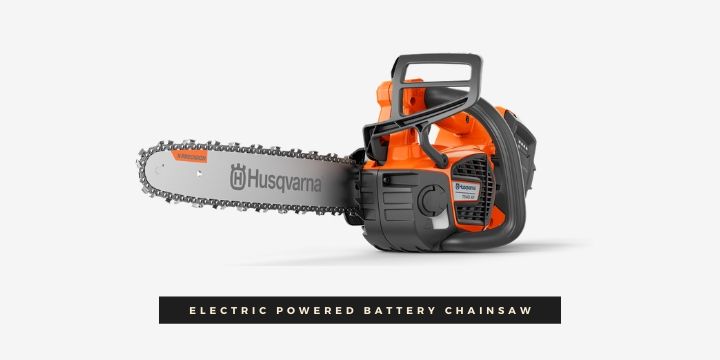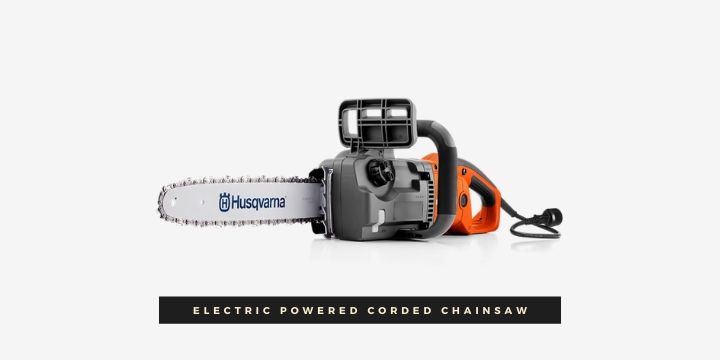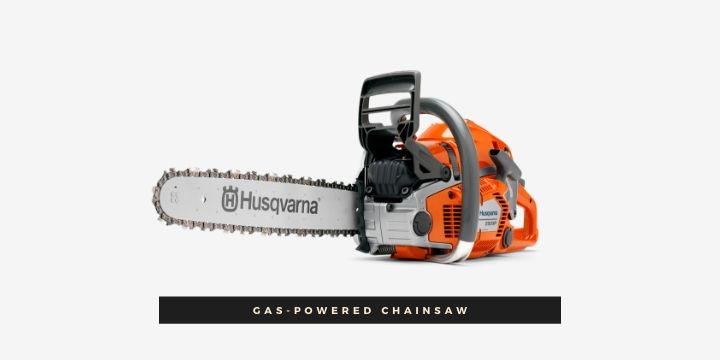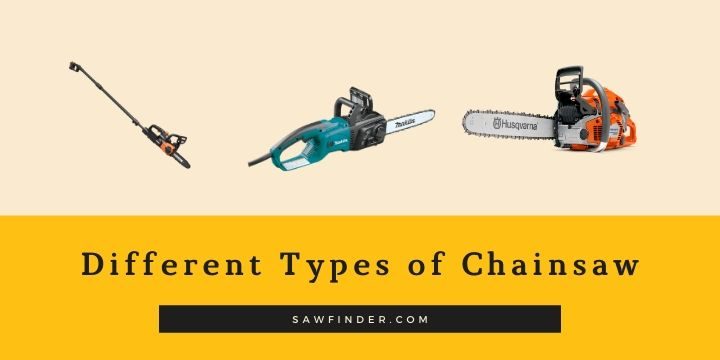A person can create or destroy while performing the most amazing and tough jobs, as long as they have two things: knowledge and the right tool for the job. Now, when it comes to working with trees, bushes, and anything made from wood or similar plant fiber, that tool is most often the chainsaw.
Perhaps you may be a homeowner looking to improve and maintain your property. Can be a woodsman/woman enjoying some weekend outdoor work, a lumberjack on the job, an artist creating a statue, or anyone else who finds the need to work with wood; you are only as capable as the tool you choose to use. All of these people’s jobs would require selecting the best tool for the task at hand, and each one of those situations requires using a different type of chainsaw.
There are five different types of chainsaws to choose from the variety. Just ahead, we will explore the various options available. So that you will have all the knowledge you need to pick the correct one, the next time you have a job to do that requires some woodwork.
The five types of chainsaws are manual, battery-powered, corded electric, gas-powered, and the pole saw. Each one has its place in your arsenal of tools. And each of them is designed for different purposes. So, if you need to do some trimming of the trees or bushes around your home, then you would be using a different type of chainsaw than you would if you were a professional getting paid for removing entire trees every day.
Let’s begin our quest of exploring the versatility of these world-changing tools, by looking closely at what makes each type different, the best uses for each model, then offer some tips for using them all. After reading this short article, you will have enough knowledge so that you can confidently pick a saw of your own- for any job you may face in the future.
The 5 Types and Their Functions:
1. The Manual/Pocket Chainsaw

The first saw up is the manual chainsaw. While not as popular or widely used as its more modern siblings, this type still has its proper place in anybody’s tool shed, toolbox, or even hiking backpack. All that this type is a chain of teeth with a durable handle attached to each end.
The simplicity of design may make the tool itself seem simple, plain, or even dull. Just know that this tool can do so much and can be used to complete yet the biggest of jobs, given enough time, and assuming the operator is in good health.
Uses of This Type
You can use the manual chainsaw for slicing up fallen trees or larger branches into manageable pieces- the right sizes for chopping with an ax. This way, a manual chainsaw can help create all that you need for making firewood to heat your home or build a campfire. You could even knock down an entire tree all on your own, using one of these. Although, as you will soon see why, this is not a very common practice.
Also, it can be used to trim off any nuisance, problematic, and even dangerous branches from any tree, bush, or shrub around your home. Mostly, this type is used for smaller jobs, though, because of the amount of the operators own energy it takes to operate.
How to Use This Type
To use one of these, you just wrap it around the branch/tree you are needing to cut, grab the handles on both ends, and begin by pulling tight against the object. Then, once strong pressure is being applied, you pull one end towards you, then pull the other end.
You alternate back and forth repeatedly, running the teeth of the chain against the tree/branch, causing them to eat a line into it slowly. Then you continue running the saw this way until you cut that line clean through; or, just until the tree can be pushed over- using its own weight to finish the job.
Our Recommended Pocket Chainsaw
Advantages
Portable: The most portable chainsaw of all; fits in any toolbox or backpack with ease.
Simple: Anyone can operate, without technical or mechanical training to maintain, fix, or manage. The only technical knowledge needed to use this type is a know-how of how to best chop down or chop up a tree of various sizes.
Value: Cheapest option of all the different chainsaws, since it is so simple and barely involves any components to build.
Easy Repair/Replace: No motor to maintain or require a fuel source. This lack of moving parts means that the only way that this saw can experience a break down is if you run out of energy or one of the handles breaks off from the chain. Other than those, this type is virtually indestructible.
Build Your Own: With just a little bit of skill and knowledge, you can easily build your own version of this type of saw. You just need to take a regular chainsaw chain and add handles to either end. The real trick is getting the handles secure enough to last through the abusive use the saw is sure to face. Usually, this involves welding, but there are other ways that creative people have used to make their own prototypes.
Versatile: Also, because of the versatility made possible by its portability, this type definitely has earned a secure spot in many tool collections. These are most often carried by loggers and backpackers alike and used as a backup to the other types. Used by the logger as a backup in case power tools experience some sort of malfunction; used by the backpackers as a source of firewood, or shelter making.
Drawbacks to This Type
Obviously, you can imagine the amount of energy and time it would take to finish even smaller jobs using one of these. You can also tell why they are not very popular or as widely used as the other four types of chainsaws.
Although the significant attraction they have going for them is the lack of need for a fuel source (other than making sure you eat and drink, but you were probably going to do that anyway, so it’s not really considered to have its own fuel source). They simply turn your body into the motor that runs them. This feature makes the manual chainsaw unique.
2. Electric Powered Battery Chainsaw

The second type is the electric motor battery-powered chainsaw. This type is typically the least powerful option available and is most often only used by your average homeowner. It is commonly used by someone who is just looking to maintain a smaller sized landscape.
While still useful and handy, the cost to benefit ratio associated with purchasing and maintaining one of these machines precludes most from owning one of their own. But if you can afford one, it is hard to beat the portability, quietness, and safety of a battery-powered chainsaw.
Uses of This Type
Mostly, this type is used for small property maintenance; such as the trimming, pruning, cutting of smaller sized trees/branches, hedges, and bushes of all kinds. In a sense, it’s like an all in one tool that can do the same jobs as others, such as loppers, shears, handsaws, hedge clippers, and many other hand tools.
This type of chainsaws versatility, combined with the portability feature, does make it an attractive option for simple domestic work. It provides homeowners with an easy and safe to operate option for replacing a wide range of typical hand-operated landscaping tools needed for maintaining an attractive property.
While powerful enough to handle bigger jobs, it is comparatively weak and often stalls or binds- when faced with a more massive sized job. So, this type is not typically recommended for jobs that require a lot of power is applied for longer periods of time. Projects like felling a medium-sized tree and then chopping it into manageable sized pieces, for example, or not in the battery-powered saws repertoire. This is mostly because limited battery life restricts run time, and a job of that size may take multiple recharges of a battery to complete.
How to Use This Type
Fairly simple and straightforward, you just need to recharge the battery before you wish to use it fully. Keep in mind that batteries can take anywhere from 2-8 hours to reach full power, depending on the maker and model. So, plan ahead, and the day before you plan to use one of these, make sure to mount the battery in the charging dock.
Then, make sure to double-check that the dock is plugged into a working power outlet, and its charging indicator light is lit up in the correct color. This should ensure proper charging. Then, when the time comes in which you need to use the chainsaw, remove the battery from the charger, and mount it into the saw itself.
Your chainsaw can then be turned on using it’s on/off switch. This is located in a different place on every machine but usually in a noticeable spot. Next, there should be a “deadman’s” switch, which will usually be located on the trigger hand in the handle area (sometimes the underside of the handle). Simply find this switch, then press and hold it down. Finally, you will have turned the machine on by engaging that switch and flipped the on/off switch to the correct positions. You can then pull the actual trigger, to apply motor power and get the chain running.
If only used for hedge/bush trimming/pruning, then you can pretty much just go to town from that point. Although, if you are going to be using the tool for chopping down a small tree- or cutting a branch from a tree and into pieces- you will need to get the chain rotating at its full speed before pressing the saw to wood. Doing this will help to prevent any problems with kickback or binding, which can potentially be dangerous for the operator.
Our Recommended Battery Powered ChainsawNo products found.
Advantages
Lightweight: This means that your arms won’t get tired while operating, even if using to trim branches overhead. This adds to both ease of use and safety features of this type of chainsaw.
Safety: Because of the weight and other essential functions, this saw is safer to use than different models. The lack of power means you have less chance of experiencing dangerous instances of kickback. So, it can be a positive feature as opposed to a negative one.
Extreme portability: This type of saw can be run anywhere, without restriction. The only limitation is the length of battery run time, but this issue can be mitigated by obtaining a second or even third battery that you can carry with you when using one of these away from a recharging power source.
Quiet running: you won’t have to deal with much noise at all while running this type of chainsaw. It doesn’t even typically require any kind of hearing protection personal protective equipment (PPE) to operate safely.
Drawbacks to This Type
Being powered by a battery means it has the typical issues, such as short running time between charges and lower power than other types. A second battery can double the work time you are offered, but since these are specially high-discharge batteries, they can be quite expensive.
They often cost so much that they become cost-prohibitive for many homeowners and workers interested in portable chainsaws. For those who can afford them, however, these are great additions to their tool arsenal.
3. Electric Powered Corded Chainsaw

This type has many of the same features and capabilities of the previously listed battery-operated model. With one major exception, and that is power. Corded type electric chainsaws can come with a more powerful motor than their battery-operated cousins because they draw off of a higher voltage (watts & amps) source.
Typically, these use the standard 110V household power outlet to supply the power that runs the motor of the saw. Although some 220V models do exist, and they offer an even more powerful option for the operator. The problem these models face is that 220V outlet locations may be restrictive.
Most households only have one such outlet, and that is in the laundry room for plugging in the clothes dryer. So, these often are only run using a gas-powered generator with the proper output. This fact makes them less demanding and not as commonly made by most manufacturers as the 110V models.
Uses of This Type
These plug-in corded power saws are used by many home and property owners for regularly needed light-to-medium landscape maintenance. Also, they are used for medium-sized projects like felling (aka chopping down) a medium-sized tree and cutting it into manageable sized pieces. All of this a corded chainsaw can accomplish, in order to remove an entire tree from a property completely.
Occasionally, this type of chainsaw is utilized by landscape firms for trimming tree branches, trimming bushes/hedges, and for shaping long rows of decorative bushes. They are used by these professionals in places like apartments, hotel properties, or office parks. They may even carry a portable power generator on their trucks, specifically for using one of these tools anywhere- even without an easily accessible or reachable, building’s power outlet.
The ease of use, safety-oriented operation and quiet running features associated with the power corded type chainsaws make their ownership an attractive option for both private citizens and contractors alike. This is also because they can replace the need for a whole range of other hand-powered and operated tools, which saves space in the garage, shed, or on the truck, and makes clean organization of tool collections more manageable.
How to Use This Type
To operate one of the corded electric chainsaws, you simply need to run an extension cord from any homes/buildings functioning standard power outlet, to wherever the area is that needs work done. Just be sure the cord itself is made with the correct power supply rating and heavy enough gauge of wire to safely operate the tool without causing it any damage.
You should always opt for heavier duty extension cords when running these tools. Look for a cord that is rated high enough, which usually means being made of a minimum 12-14 or bigger gauge wire. Look for a heavier gauge if it’s an especially long cord, or if you’re going to be running two to three cords, in order to reach the work zone. Then, before you use it, always make sure that the cable is in proper condition. This means you need to make sure it has no splices, frays, kinks, or exposed wire. This is because a bad extension cord can cause a whole host of safety related issues that should always be avoided.
After these requirements are met, you simply plug the cord into an outlet and the saw. Then, again, you will need to locate the deadmans switch, hold it down, and then pull the trigger to engage the motor and get the chain spinning. Also, again, you will want to get the motor running at full power before engaging any larger trees or limbs. You do this in order to prevent any instance of kickback, which can be dangerous- especially for amateur operators. Plus, you need to keep the trigger fully pressed, all the way through your cut; doing so will ensure you don’t experience any binding.
Our Recommended Electric Powered Corded Chainsaw
Advantages
Quiet: Extremely quiet running motor, even under full power. This reduces the need for PPE like heavy-duty hearing protection (although it is still recommended that you wear these while using, especially for longer periods of time).
Power: More powerful than the battery-operated electric types. These can work through tougher and larger jobs than their battery-operated cousins due to the increase in motor power. This increase is supported by the fact that they plug into a 110V power source rather than the 12V, 18V, up to the newest top of the line 36v batteries the others typically runoff.
Value: Probably the most reasonably-priced/ affordable option of all the different types these chainsaws are the best value overall. Especially when you consider all the features and compare them to the drawbacks from gas or battery-powered models. As long as you plan to mostly use yours to maintain the property directly around your home, then this is definitely the type of saw for you.
Drawbacks To This Type
The fact that you need a power source to plug into is the major drawback to this design of chainsaw. This is because it limits the portability features of this type, by lowering the usable range it provides. While this doesn’t affect the typical homeowner, or restrict the ability to maintain the average landscaping area of a typically sized home property.
4. Gas-Powered Chainsaw

The gas-powered chainsaws are by far the most used and sought out of all the five types. They are the industry standard for loggers, general contractors, and a range of other professional users of chainsaws. These types of saws are often used for everything from felling and chopping up trees of all sizes, all the way to milling pieces of lumber from felled trees (using a portable lumber mill attachment).
The popularity and versatility of this type of chainsaw are what have gained these tools, their notoriety, and their infamous reputation. They are considered to be an absolute necessity for many, including serious handyman, campers, or many different skilled craftsmen/ tradesmen.
Uses of This Type
This type of chainsaw can tackle just about anything. They are often put to the test by workers in many different professions, and they universally pass every time. They are the most powerful type of chainsaw and lead the pack by leaps and bounds above the others.
As they are the most powerful option, this type can be used to fell trees of any size (the only limitation is from the size of the bar, and there is up to a 36-inch bar size in professional-grade gas-powered chainsaws).
This means that you can do just about any job or project using one of these amazing machines. They are widely used by many professionals. Also, this type is known to do everything from commercial logging to artistic sculpting of statues from logs or ice blocks.
How to Use This Type
Now, gas-powered chainsaws require a lot more work to maintain and use properly, although the advantages you are afforded with these machines make this investment of time and energy well worth it.
To begin, you first check to make sure that you have plenty of fresh fuel in the tank. Old fuel that has been sitting for long periods of time can become sludge-like. This ‘sludge’ fuel can cause significant problems for you during the use of your chainsaw. So, if the need is there, you can always empty and rinse out the tank, then fill with fresh fuel, and you’re on your way.
The next thing to check out before starting is your air filter. You want to make sure that the air filter is fairly clean and free of significant amounts of dust, dirt, or debris. This is because getting any of these contaminants mixed into your fuel supply, as it gets fed into the engine, can cause severe issues and damage your chainsaw. So, if you need to replace the filter, or simply shake off some sawdust, then now is the time to do that.
The final thing you want to check is the shape of the chain and bar itself. Is the chain relatively taught? You should have about 1/8th of an inch of giving/play. To test this, you just need to pull on the chain, away from the bar, and see how much give it has.
Next, are the chain’s teeth sharp? If not, you can buy a kit for sharpening the teeth in order to get the best performance from your chainsaw. In fact, Any and All of the five different chainsaw types benefit highly from having a well-sharpened chain. Finally, is the chain and bar area well lubricated and the bar oil reservoir relatively full? If not, then now is the time to full it.
Once all this is in order, you can then start the machine up and get to work. In order to start it, you find the deadman’s switch and make sure you have it held down. Then, you pull quickly on the pull starts cord; by firmly gripping the handle- in the opposite hand than the one holding down the dead man’s switch- and yanking it upwards, while simultaneously pushing the machine itself downwards- using the other arm. So, this just means that you will be pushing down with one hand and arm while you’re also pulling up with the other.
Then, you just keep repeating this action until you get the engine to sputter to life. Using this motion correctly, will give you the maximum amount of power into your pull start action and will help you to start the machine with the least number of attempts.
Our Recommended Gas Powered ChainsawNo products found.
Advantages
Portability: You are only limited by how far you’re willing to carry your chainsaw and fuel supply. You do need to bring a gas can, but other than that, your equipment load is relatively light compared to the amount and types of work you are able to complete using a gas-powered chainsaw.
Power: The most powerful option of all, opening up a whole other world to your working abilities. You can tackle the biggest of jobs using one of these. No matter how large that tree is that needs to go, you can easily tackle the job of removing it. With just a little bit of know-how and plenty of gasoline to keep you going, you will easily turn it into firewood.
Repairable: Easier to fix most problems encountered, on your own, when operating a gas-powered chainsaw, than it is the other types. If you have a basic understanding of how combustion engines work, you can do a lot of jobs using your saw. And be confident in your ability to resolve any issue that may arise using a limited tool supply, like the situations you might face when working out in the woods and far away from town.
Size of Bar/Chain: This type comes with the widest range of possible bar size. This range offers the best chance at finding the absolute perfect fitting tool for any job you may be faced with completing. Including up to the giant commercial size jobs of felling many hundreds or thousands of trees with extremely large-sized trunks. They come in sizes up to 36 inches of bar size and go down to match the smallest of bar sizes at 12 inches in length.
Drawbacks to This Type
The major drawbacks to running a gas-powered chainsaw are the amount of noise and the fumes. First, since you are running a gas motor to drive the power of your chainsaw, you will be producing a large amount of noise, especially at full power. You can, and should, mitigate this noise using a high-quality PPE, in this case, earplugs.
Secondly, the amount of exhaust fumes you will be making can cause issues after prolonged exposure, including lightheadedness, nausea, or other minor health problems. But these are rare occurrences, but if you are sensitive to those kinds of fumes, this could be an issue that would affect your performance while using a gas-powered chainsaw.
5. Pole Chainsaw

The fifth and final type of chainsaw is the pole saw. Typically, they are gas-powered, but there are battery and electric versions available. This is just a chainsaw, mounted at the end of an extension pole, with cable-operated controls. These cables connect the operator’s end to the operating end of the pole. This makes it possible to run the saw, using a full range of controls by the operator without them needing to hold on to the saw itself directly.
Uses of This Type
This type of saw is used to expand your reach; when trimming branches on trees, from the ground or from a ladder. These are commonly used by arborists, who trim a large amount of low hanging branches. This is because they do not want to run the safety risk of constantly running a chainsaw over their head by holding the machine up there themselves- and wearing out their arms. Which can place someone into a dangerous circumstance, and with this type of chainsaw, these situations can be wholly avoided.
How to Use This Type
To operate a pole saw, you simply engage the power source by plugging in the power cord, mounting the battery, or starting up the gas engine. You do so following the same instructions as each of the corresponding chainsaw types previously covered.
Then, you pull the trigger, or on some saws, this will be a cable/cord that hangs from the saw itself, which you pull on. With the cord types, the amount of tension you applied while pulling, directly affects the amount of power your saw is running at. You then simply direct the saw itself to the branches you want to chop off and apply just enough pressure into cutting through each one. It may seem awkward at first but becomes more comfortable after some practice.
Our Recommended Pole Chainsaw
Advantages
Separation: Gives you a wider range of cutting distance from your target. This means you can stay a safe distance away from falling branches when performing regular tree trimming and maintenance tasks.
Simple: Very easy to use after a little bit of practice. You will actually appreciate the simplicity you will experience using this type of chainsaw.
Safety: Saves the operator from being placed into precarious and dangerous situations they may encounter. For example, standing on a ladder and using another type of chainsaw above their head with arms outstretched. You can easily see how this could be a dangerous situation to be working in. With a pole saw, you could avoid these situations altogether.
Increases Reach: Whether up a ladder or working from the ground, the number of tree branches you can reach for trimming or removing increases compared to the typical hand-held types of chainsaws. This speeds up the time it takes to finish the job and allows you to move on to other projects you may have on your “honey do” list.
Drawbacks to This Type
While useful in certain situations, you are limited in options and in the versatility of the saw of uses. If you are a homeowner just looking to trim back nuisance branches and keep the taller trees on your property properly manicured and shaped, then this is the saw for you.
Buying Guide for Chainsaws
When faced with all the different types, it can be confusing or overwhelming to decide which is the proper version for you. Hopefully, you now have a clearer sense of each type of saw and what they are used for or can do for you. To choose the proper type, you just need to think about what all you want to do with the chainsaw you get, and where you will be using it.
If it’s just around home doing basic landscaping types of tasks, then you can easily accomplish those goals using an electric corded saw. Or, maybe you need a little more range for using your saw, say for a bigger property where you will be trimming trees or bushes that are a bit farther away from a power outlet. If this is your situation, then you may want to opt for the battery or gas-powered options.
Also, maybe you plan on using it to fell and chop up trees out in the woods, away from regular power sources, and require a more powerful tool. In this final case, you will definitely want to obtain a gas-powered saw for your work.
Whatever the job at hand is, and wherever it needs to take place, there is the correct tool for the job. Now that you are more informed about each option, you should be able to make an educated decision about the proper chainsaw for you.
You will enjoy using your saw and will get much more work done in a shorter amount of time using one of these. So, think about your options and pick one out. You’ll be glad you did.
Related Topics:
Last update on 2024-10-25 / Affiliate links / Images from Amazon Product Advertising API



![Pocket Chainsaw For Camping [36 Inch Heavy Duty Tool] -Manual Chain Saw, Survival Wire Saw -Rope...](https://m.media-amazon.com/images/I/51RxXVVLOKL._SL160_.jpg)






